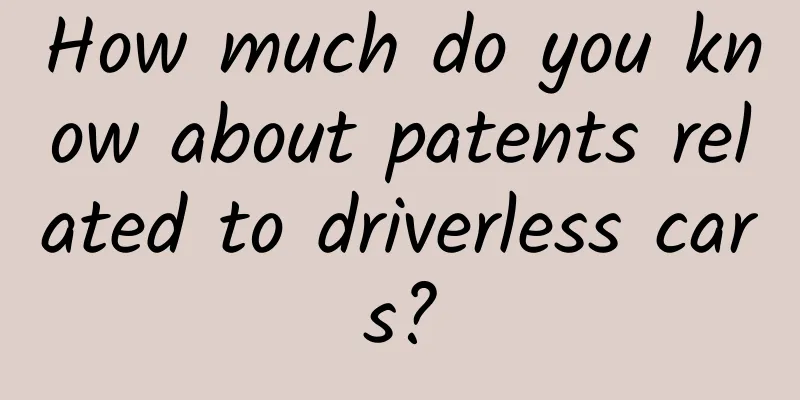How much do you know about patents related to driverless cars?

|
In terms of the development progress and experience accumulation of driverless cars, Google is already in the leading position, followed closely by international automobile manufacturers. Google wants to realize the innovative concept of driverless cars in one step, while Mercedes-Benz, BMW, Audi and other automobile manufacturers are taking an "evolutionary" approach, adding new functions step by step, leading consumers to gradually adapt to a completely different driving experience. Speaking of self-driving cars, everyone immediately thinks of Google, and this impression is deeply rooted in people's minds. After all, since Google first announced its self-driving car testing plan in 2010, the "Google Self-Driving Car" (see Figure 1) has accumulated more than 700,000 miles of actual driving experience on the road, and the accident rate is zero. This is really an unprecedented novelty for the general public, and it also makes people admire Google's innovative ability. It’s just that this future technology is too far away from the life experience of ordinary people, so they don’t feel it deeply. Moreover, it has been several years since then, and the novelty is gone. Most people just treat driverless cars as a topic. Figure 1: Google driverless car Currently, in addition to Google's continued investment in the research and development and improvement of driverless cars, which has achieved considerable results, international automobile manufacturers also recognize this trend and are treating this technology seriously and pragmatically. At this year's 2015 CES Consumer Electronics Show, driverless cars once again became the focus of everyone's attention. For example, the driverless car "F015 Luxury in Motion" (see Figure 2) exhibited by Mercedes-Benz has the biggest feature that when driving automatically, the driver can turn the front seat 180 degrees to interact with other passengers. The car is like a mobile luxury box. Coupled with the sci-fi and avant-garde interior and exterior design and equipment, it naturally attracted the attention of the whole audience. However, this is only a conceptual presentation. It is expected that this type of car will not be officially launched until 2030. Figure 2: Mercedes-Benz F015 Luxury in Motion BMW has partnered with Samsung Electronics to demonstrate the fully automatic driverless Remote Valet Parking Assistant technology (see Figure 3). Through the smart watch Gear S, the driverless car can be remotely controlled to automatically park in the parking lot, and the car can also be remotely controlled to automatically drive to the owner's location. However, the prerequisite is that the parking lot must also be equipped with sensors that can communicate with the driverless car. Figure 3: BMW Remote Valet Parking Assistant Audi has launched an unmanned driving concept car called "Jack" based on the A7 model (see Figure 4). The car has the functions of automatic lane change and cornering, as well as automatic acceleration and braking. More importantly, the car has also been tested on the road. During the 2015 CES exhibition, "Jack" "drove" all the way from Silicon Valley to the CES exhibition hall in Las Vegas, helping himself accumulate 500 miles of actual driving experience. Figure 4: Audi A7 Jack However, as Alex Davies, a writer for Wired magazine who was riding in "Jack" at the time, described it, "Audi's driverless car may seem like a glorified upgrade to the smart cruise control, lane departure warnings and other semi-autonomous technologies that are now available in many luxury cars." The reason why people have such a feeling is that compared with the driverless car released by Google, Audi's driverless car looks no different from an ordinary car, and the entire autonomous driving process will not make the driver feel unusual. After years of actual testing, Google first released its self-driving car mockup in May 2014 (see Figure 5). In addition to its cartoon-like appearance and the impressive LIDAR (Light Detection And Ranging) system on the roof, it also has a very impressive appearance. What is most subversive to traditional perceptions is that the entire car has no steering wheel, no accelerator pedal, and no brake pedal. There are only two buttons for passengers to manually control emergency stop or advance. The rest of the driving work is left to sensors and computers, because Google's concept is that the process of unmanned driving does not require human intervention. Figure 5. Google Self-Driving Car (left) model (right) prototype The prototype of the autonomous car released in December 2014 was a smaller LIDAR system with physical headlights installed. In addition to the necessary sensors and computers, the steering wheel and brake pedals were also installed. This combination seems to have compromised the original vision of "no human control at all". But on the other hand, at this stage, how many people can accept a car without a steering wheel? The most important issue is to meet the actual needs of consumers. Innovation that is too far-fetched will discourage people. There is no doubt that Google is in the lead in terms of the development progress and experience accumulation of driverless cars, followed closely by international automakers. However, Google wants to realize the innovative concept of driverless cars in one step, while automakers are taking an "evolutionary" approach, adding new features step by step, leading consumers to gradually adapt to a completely different driving experience. Putting aside the many legal, insurance, and consumer acceptance issues that driverless cars will face before they are officially launched on the market, let's take a look at the important technologies that driverless cars contain. According to a report by Lexinnova, a US patent consulting company, nine basic technologies that have been used in driverless cars are summarized (see Figure 6): Vehicle-to-Vehicle Communication, Cruise Control, Automatic Brakes, Lane Keeping, Radar, Traction or Stability Control, Video Camera, Position Estimator, and Global Positioning System (GPS). Among the above basic technologies, the number of patent applications for the first five technologies is relatively large, which also shows their importance, so the following is a brief introduction to these five technologies. Figure 6. Basic technologies of driverless cars 1. Vehicle-to-Vehicle Communication (V2V Communication) Through vehicle-to-vehicle communication, vehicles can transmit data to each other, so that they can understand each other's behavior and status, allowing drivers to make judgments and decisions in advance, reducing the dangers caused by blind spots in vision. Figure 7. Schematic diagram of V2V Communication The National Highway Traffic Safety Administration (NHTSA) is developing standards and specifications for vehicle-to-vehicle communications to ensure that all vehicles use a common language, and the U.S. Department of Transportation has also announced that new cars shipped as early as 2017 will be required to be equipped with vehicle-to-vehicle communication systems. The vehicle-to-vehicle communication system developed by NHTSA uses the dedicated short-range communication (DSRC) technology based on IEEE802.11p and IEEE 1609 standards. It transmits data via the 5.9GHz microwave frequency band and has the characteristics of ultra-low transmission delay and high transmission speed. In the DSCR mesh network, each node (car) transmits signals to all directions at a frequency of 10 times per second, with a coverage range of 300 meters. The data received in the network can jump forward to 5 to 10 nodes (cars) in a multi-hop manner, just like collecting traffic conditions one mile away, which gives drivers sufficient time to respond to traffic conditions. According to Lexinnova, most of the patents related to vehicle-to-vehicle communication are held by Toyota Motor and its subsidiary Denso, followed by Japanese automotive electronics company Alpine and General Motors (GM). 2. Cruise Control Traditional cruise control systems will automatically adjust the engine throttle opening according to the set cruising speed to achieve the purpose of constant speed driving. Intelligent cruise control system (ACC, AdaptiveCruise control) will actively detect the distance to the vehicle in front, and appropriately control the throttle and brake based on the safe following time interval specified by the system and the speed set by the driver, thereby achieving cruise control that adapts to the situation of the vehicle in front. Figure 8. Schematic diagram of Adaptive Cruise control The ACC system is mainly composed of a front vehicle distance detector, a vehicle speed sensor, a longitudinal acceleration sensor, a brake and throttle control unit, and a logic operation control unit. According to Lexinnova's statistics, the top three patent holders of cruise control-related patents are: Robert Bosch, Nissan Motor, and General Motors. 3. Automatic Brakes The automatic braking system includes an anti-lock braking system (ABS) and an electronic brake-force distribution (EBD) system. Figure 9. ABS schematic diagram ABS was first introduced to the market by Bosch in 1987 and is now a fairly common feature. When you apply the brakes, ABS will detect the wheel speed through the sensor components. Once it detects that the wheels are locked, ABS will release the brakes, then quickly brake to lock, then release again and lock again, and so on, so that the driver can still control the steering wheel to avoid slipping and losing control. EBD is an additional system of ABS, which works before ABS to reduce unnecessary ABS action. The EBD system monitors the speed of the four wheels and automatically adjusts the brake oil pressure of each wheel to the most appropriate level to prevent any deadlock before ABS takes effect, thus increasing the protection range. According to Lexinnova, the main patent holders of patents related to automatic braking systems are South Korean auto parts supplier Mando Corporation and Bosch, but Mando Corporation's ABS or EBD patents do not seem to be used in the field of driverless cars. 4. Lane Keeping Lane keeping techniques are classified into the following two categories: Lane Departure Warning System (LDWS), when the sensing component detects that the vehicle has deviated from the lane, if the driver does not turn on the turn signal to change lanes, the system will issue a visual, auditory or vibration warning signal to remind the driver to return to the lane. Lane Keeping System (LKS) or Lane Keeping Assist System (LKAS) is when the vehicle accidentally deviates from the lane and the driver does not immediately deal with the deviation, LKAS will actively intervene to control the steering wheel and provide appropriate assistance to keep the vehicle in the original lane. Self-driving cars use this system, and the sensors can use image sensors, laser sensors, or infrared sensors. Figure 10. Schematic diagram of Lane Keeping Assist System (LKAS) According to Lexinnova's statistics, the top four patent holders of lane keeping system-related patents are Bosch, Nissan Motor, Toyota Motor, and Hyundai Motor. 5. Radar The radar system is one of the most important technologies for driverless cars. In addition to the reversing radar we are familiar with, radar is used for cruise control, detecting surrounding traffic conditions, anti-collision system, and lane keeping. Figure 11. Schematic diagram of automotive radar application Automotive radars are divided into three types: acoustic radar, optical radar, and millimeter wave radar, depending on the signal source. Ultrasonic radar, which belongs to the sound wave category, is mainly used in parking assistance systems, such as reversing radar, because of its short measurement distance. The main disadvantage of infrared radar and laser radar, which belong to the light wave category, is that the light penetration is easily disturbed by dust, rain, fog and snow, which affects the accuracy of measurement. The measurement distance of infrared radar is short and can be used in night vision systems, while the measurement distance of laser radar is long. Like infrared radar, both can be used in anti-collision systems. As the name indicates, the wavelength of millimeter-level (mm) millimeter-wave radar operates in the range of 30GHz to 300GHz, mainly concentrated in the 23~24, 60~61, 76~77GHz bands. It is the mainstream of automotive radar research and development. Compared with sound waves, millimeter-wave radar is not affected by atmospheric turbulence. Compared with light waves, millimeter-wave radar has stronger penetration, so millimeter-wave radar has good detectability and high accuracy. In addition to radar systems, driverless cars also use LIDAR systems, which is optical remote sensing technology. It usually uses laser light pulses to perform high-density scans of targets to measure the distance of the object or obtain data on the object's three-dimensional shape. According to Lexinnova's statistics, the top four patent owners of radar-related patents are Toyota Motor, Hitachi, Bosch and Fujitsu. in conclusion Before driverless cars are officially launched on the market, in addition to facing complex regulatory issues, there are still many technical problems to be overcome, such as the stability and accuracy of various sensor components, the security of vehicle-to-vehicle communication, software integration, operational judgment procedures, etc. These various technical issues will eventually converge into the price issue that consumers are most sensitive to. In fact, the basic technologies required for driverless cars are all re-development and improvement of existing technologies, but the integration and application of these technologies is a kind of innovation and invention. We expect this creative power to bring huge business opportunities to the technology industry and the automotive industry, and hope to create a safer and more efficient driving environment, as well as a more energy-saving and environmentally friendly lifestyle through the power of technology. As a winner of Toutiao's Qingyun Plan and Baijiahao's Bai+ Plan, the 2019 Baidu Digital Author of the Year, the Baijiahao's Most Popular Author in the Technology Field, the 2019 Sogou Technology and Culture Author, and the 2021 Baijiahao Quarterly Influential Creator, he has won many awards, including the 2013 Sohu Best Industry Media Person, the 2015 China New Media Entrepreneurship Competition Beijing Third Place, the 2015 Guangmang Experience Award, the 2015 China New Media Entrepreneurship Competition Finals Third Place, and the 2018 Baidu Dynamic Annual Powerful Celebrity. |
<<: Cloud computing enters the US: Alibaba's strategic defense
>>: Luo Xiaobu: Broadcasting and TV operators who block IPTV/OTT are hopeless
Recommend
Toutiao search engine introduction and account establishment process
This article will share with you an introduction ...
Honor Play 5X pictures with eye-catching metal brushed craftsmanship
The Honor brand is positioned in the younger mark...
Chun Shui Tang, the "Xiaomi doll" brand: with a price of 2999, the quality is comparable to that of silicone dolls worth tens of thousands of yuan
Humans seem to have an innate love for puppets. I...
FAW Audi dealers: Stop picking up imported and domestically produced cars in December
This winter is particularly cold for Audi and FAW...
Costs are reduced by 50%, here are tips for placing OCPC information flow ads!
As the end of the year draws closer, optimizers a...
How to maintain a Douyin Life Account? How to maintain your Douyin account on a daily basis?
In fact, many Douyin influencers also want to mai...
Rivian surpasses Volkswagen and BYD ranks third in the global auto company market value ranking in November 2021
Driven by Tesla, the market value of new energy v...
A "minor cold" causes indicators to soar, 10,000 times higher than normal values. Be alert to the onset of myocarditis!
Recently, a girl in Guangdong had persistent coug...
What kind of content on Douyin can be easily monetized? What kind of content on TikTok is easy to monetize?
Douyin is not just a self-media platform for leis...
Why doesn’t the iPhone use USB-C but Lightning?
USB-C is becoming more and more widespread, and m...
The most touching marketing cases in 2021
It was screen-sweeping, heart-breaking, and defen...
Reminder! Heavy rain has returned early, please take precautions!
The holiday is coming to an end Good weather &quo...
Summary of NetEase’s screen-sweeping rules: How to master the H5 fission methodology?
It has become a rule in 2018 that any product pro...
What are the functions of Lanzhou Financial Mini Program? How much does it cost to make a financial app?
With the advent of the 5G era, the financial indu...
Technology changes coffee: Onecup turns you into a top barista in seconds and beats Starbucks
As an imported drink, coffee has gradually been a...









